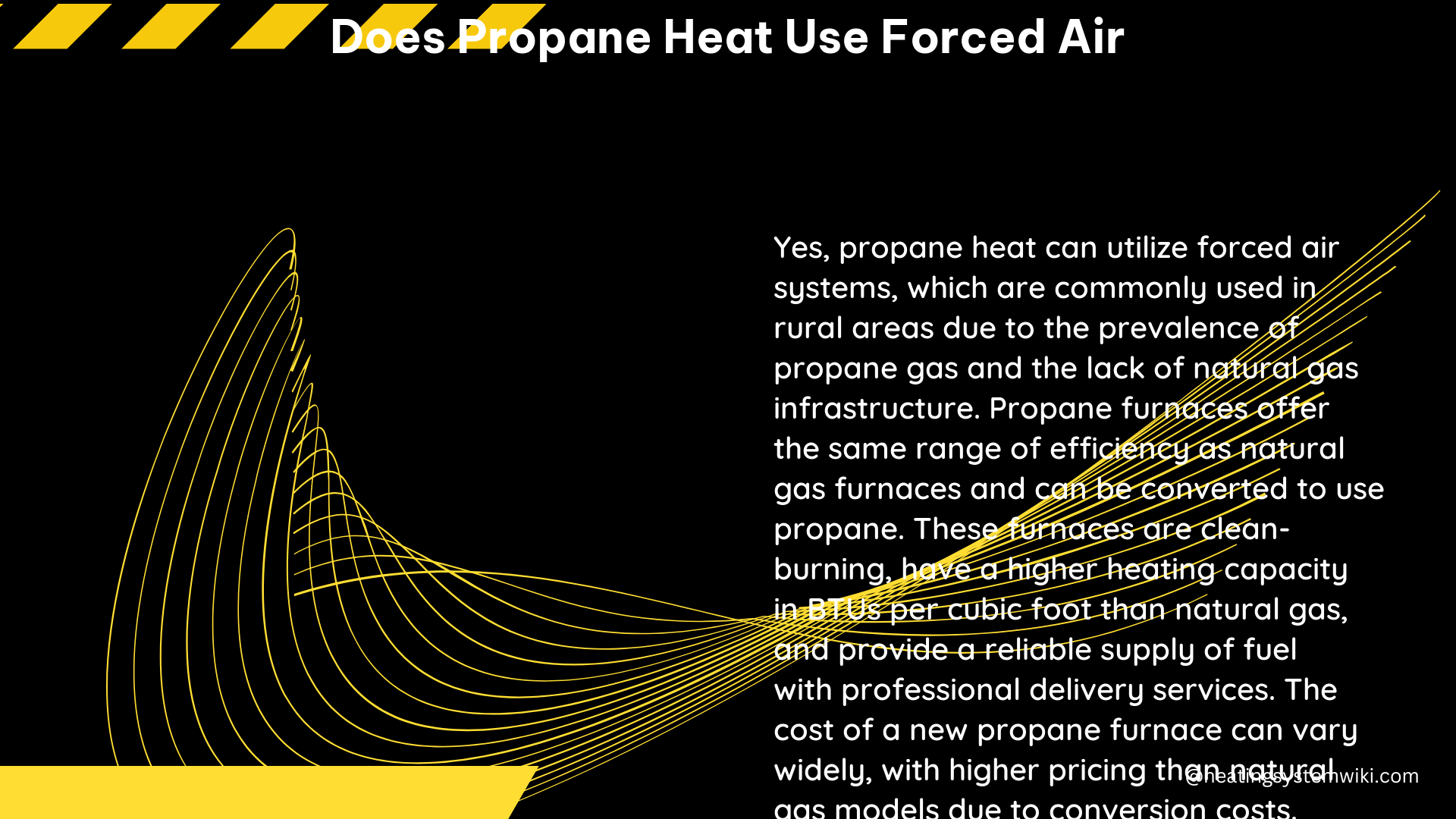Propane heat can indeed use forced air as a method of heat distribution. Forced air heating systems work by using a furnace to heat air, which is then distributed throughout the home via ductwork and vents. Propane furnaces are a type of forced air heating system that uses propane as the fuel source. They are known for their high heating capacity, efficiency, and ability to provide even, consistent heat.
Propane Furnace Heating Capacity
When it comes to technical specifications, propane furnaces vary in terms of their heating capacity, measured in British Thermal Units (BTUs) per hour. For example:
| Propane Furnace Model | Heating Capacity (BTU/hr) | Suitable for |
|---|---|---|
| Master 375,000 BTU LP Forced Air Heater with Thermostat | 375,000 BTU/hr | Large commercial or industrial settings up to 9,300 sq ft |
| Sunnydaze 60,000 BTU Forced Air Propane Heater | 60,000 BTU/hr | Residential use up to 1,500 sq ft |
| Carrier Infinity 98 Propane Furnace | 60,000 – 120,000 BTU/hr | Residential use up to 3,000 sq ft |
| Rheem Classic Plus Propane Furnace | 40,000 – 120,000 BTU/hr | Residential use up to 2,500 sq ft |
The heating capacity of a propane furnace is an important consideration when selecting the right system for your home or commercial space. Factors such as the size of the space, insulation, and climate will all impact the required heating capacity.
Propane Furnace Efficiency

Propane furnaces are known for their high efficiency, with many models achieving AFUE (Annual Fuel Utilization Efficiency) ratings of 90% or higher. This means that 90% or more of the fuel energy is converted into usable heat, making propane furnaces a cost-effective and energy-efficient heating solution.
Some key factors that contribute to the high efficiency of propane furnaces include:
- Condensing Technology: Newer propane furnace models often incorporate condensing technology, which extracts additional heat from the exhaust gases, resulting in higher efficiency.
- Modulating Burners: Propane furnaces with modulating burners can adjust their output to match the heating demand, reducing energy consumption and improving temperature control.
- Variable-Speed Blowers: Propane furnaces with variable-speed blowers can adjust the airflow to match the heating demand, further improving efficiency and comfort.
Propane Furnace Installation and Maintenance
In terms of DIY installation, it is generally not recommended to install a propane furnace without professional assistance. Propane furnaces require specialized knowledge and skills to install and maintain safely and efficiently. They also require proper ventilation and combustion systems to ensure safe operation.
The installation of a propane furnace typically involves the following steps:
- Site Evaluation: A qualified HVAC technician will assess the size, layout, and insulation of the space to determine the appropriate furnace size and configuration.
- Ductwork Installation: The technician will install or modify the ductwork to ensure proper air distribution throughout the space.
- Electrical and Gas Connections: The propane furnace will be connected to the home’s electrical and gas supply, ensuring compliance with local building codes and safety regulations.
- Venting and Combustion Air: Proper venting and combustion air supply are critical for the safe operation of a propane furnace, and the technician will ensure these systems are installed correctly.
- Thermostat Installation: The technician will install a compatible thermostat to control the furnace’s operation and temperature settings.
Regular maintenance is also essential for the safe and efficient operation of a propane furnace. This typically includes:
- Annual inspections and tune-ups by a qualified HVAC technician
- Changing the air filter regularly (typically every 1-3 months)
- Cleaning the furnace’s blower and other components as needed
- Checking and adjusting the furnace’s gas pressure and combustion settings
By following these installation and maintenance best practices, you can ensure that your propane furnace operates safely, efficiently, and provides consistent, comfortable heating for your home or commercial space.
Conclusion
In summary, propane heat can use forced air as a method of heat distribution, and propane furnaces are a type of forced air heating system that uses propane as the fuel source. Propane furnaces vary in terms of their heating capacity, efficiency, and suitability for different applications. While propane furnaces are known for their high heating capacity and efficiency, it is essential to have them installed and maintained by qualified HVAC professionals to ensure safe and optimal operation.
References:
- Propane Heating Furnace 101 – AmeriGas
- What to Know When Buying a Home with Propane Heat – Smart Touch Energy
- Master 375,000 BTU LP Forced Air Heater with Thermostat – Master Industrial Products
- Sunnydaze 60,000 BTU Forced Air Propane Heater – Amazon
- Propane Furnaces – Carrier
- Rheem Classic Plus Propane Furnace – Rheem
- Infinity 98 Propane Furnace – Carrier
